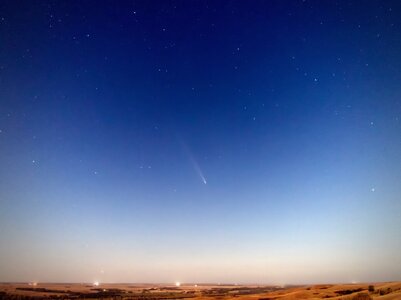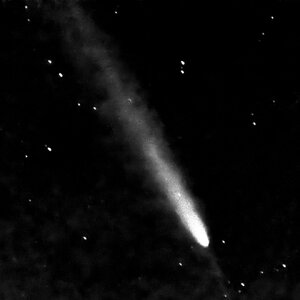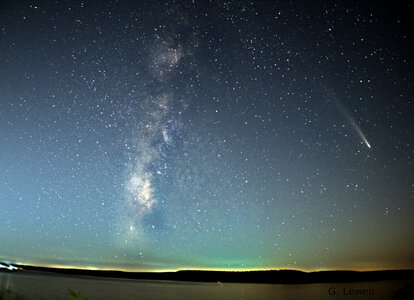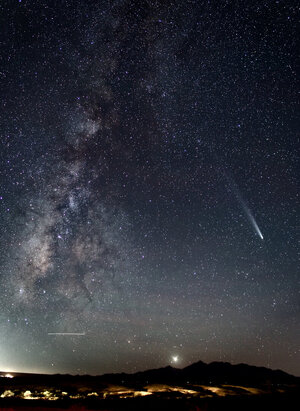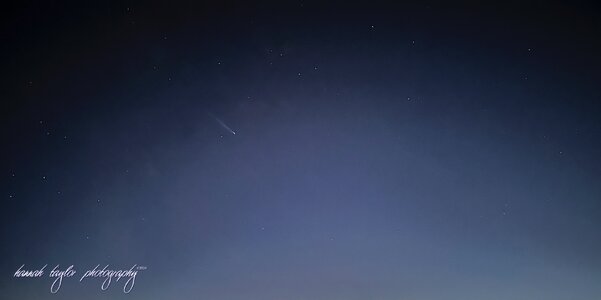-
While Stormtrack has discontinued its hosting of SpotterNetwork support on the forums, keep in mind that support for SpotterNetwork issues is available by emailing [email protected].
You are using an out of date browser. It may not display this or other websites correctly.
You should upgrade or use an alternative browser.
You should upgrade or use an alternative browser.
Comet Tsuchinshan-ATLAS
- Thread starter William Monfredo
- Start date
gdlewen
EF4
This was taken with a hand-held iPhone 15 this evening overlooking Skiatook Lake at 8PM CDT--using the iPhone 15's Night Mode. The full moon has risen behind the camera, and "paints" the foliage in the foreground.
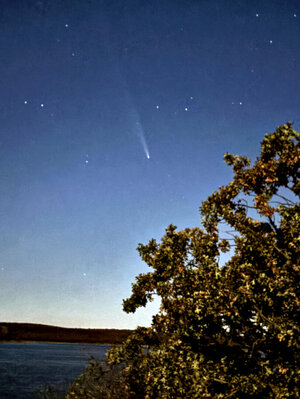
I took several sets of images with my Z6 for stacking, and will probably use them to practice with the stacking software because this comet is a good subject for learning.
But honestly, this simple picture really is good enough to preserve the memory. If you have a smart phone with similar night mode capability you should get out there and take the shot, weather permitting of course!

I took several sets of images with my Z6 for stacking, and will probably use them to practice with the stacking software because this comet is a good subject for learning.
But honestly, this simple picture really is good enough to preserve the memory. If you have a smart phone with similar night mode capability you should get out there and take the shot, weather permitting of course!
Dan Robinson
EF5
Fourth try was the charm here Wednesday night, with crystal-clear skies free of clouds and smoke. Those conditions finally allowed the long tail to show up. This again a 2-frame blend of back-to-back exposures of 0.4 seconds and 6 seconds, F3.5 Canon 50mm at 400ISO. I need to ask the NPS if they'd consider shutting the lights off for events like this. They do it for birds!
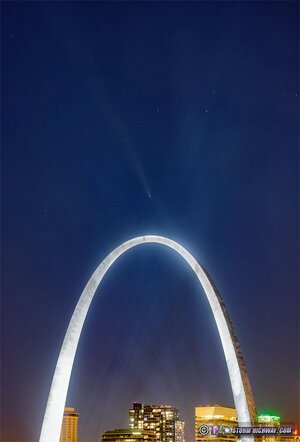
Added to the Gateway Arch gallery here:

Added to the Gateway Arch gallery here:
William Monfredo
EF4
John Farley
Supporter
After a fails the previous couple nights (clouds Tuesday night and poor planning the previous night), I finally got some pictures of the comet last night. These were taken on the northwest fringes of Rio Rancho, NM.
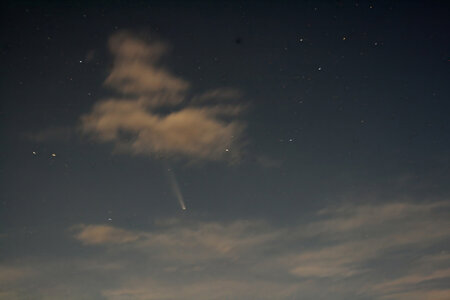
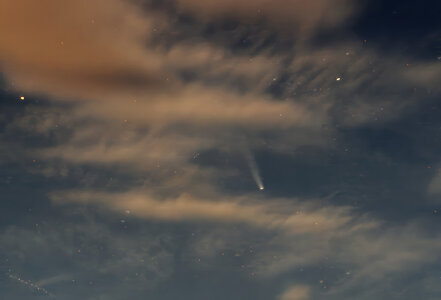
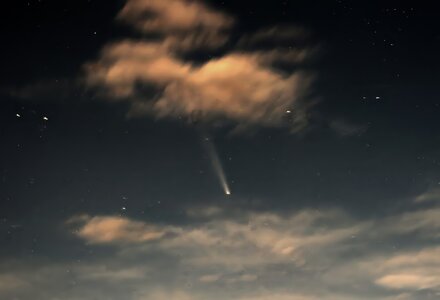
This was one of the very few places in northern New Mexico that was not totally overcast. I drove through rain to get there, but could see both visually and on satellite imagery that a relatively clear area was moving into that area from the southwest.



This was one of the very few places in northern New Mexico that was not totally overcast. I drove through rain to get there, but could see both visually and on satellite imagery that a relatively clear area was moving into that area from the southwest.
Last edited:
gdlewen
EF4
OK so this is 30 images (Nikon Z6 w/ Nikkor-Z zoom lens @77mm, f/6 and 2.5 sec exposure) stacked with Deep Sky Stacker 5.1.6. I think this set used too high of an ISO for stacking, set at ISO2000. I have other sets at lower ISO to try. The stacking and focus are good--the stars are nice and round and you can even see the "anti-tail". But the background is too bright. I've seen better pictures posted by others, so it's clear there's room for improvement.
We have clear skies again this evening in NE OK. Any suggestions from ST if I go back out again tonight? It might be worth it to see how long of an anti-tail I can capture.
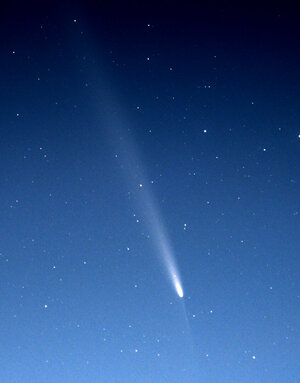
We have clear skies again this evening in NE OK. Any suggestions from ST if I go back out again tonight? It might be worth it to see how long of an anti-tail I can capture.

Last edited:
William Monfredo
EF4
Found this site afterwards...it might be helpful in the future. It allows you to change the object of interest & location on earth to see the sky view.Is there a good source for the comet's position in the sky? Something like the Photographer's Ephemeris that shows a map?

Star Maps: Comet C/2023 A3 (Tsuchinshan-ATLAS) | TheSkyLive
Find Comet C/2023 A3 (Tsuchinshan-ATLAS) in the sky using our interactive Star Maps and Planetarium web application.
Last edited:
Tony Laubach
EF5
Was a nice excuse to get out for an hour the last few evenings to sit behind a camera and enjoy some quiet... here are a few shots from around my home area here in northern Colorado...












Dan Robinson
EF5
One more night shooting this (the 6th in a row) this time at my go-to dark-sky astrophotography spot outside of my town. I know I've ran this spot into the ground with meteors and auroras, but we unfortunately don't have any cool windmills, barns or other interesting things in low-light spots within 20 miles. I wanted to at least get one proper exposure of the comet. This with the Canon 50mm F1.8 wide open at 800ISO at 6 seconds.


A couple more here:


A couple more here:
Dan Robinson
EF5
On the subject of how phones do with photography these days: here is an example of a shot from my iPhone 15 pro.
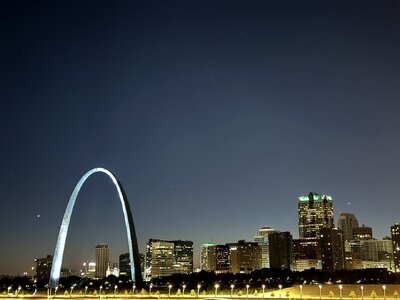
At first glance, this looks amazing. The city and the comet are almost properly exposed with no blown-out highlights. But when you look a little closer, you see the trade-off:
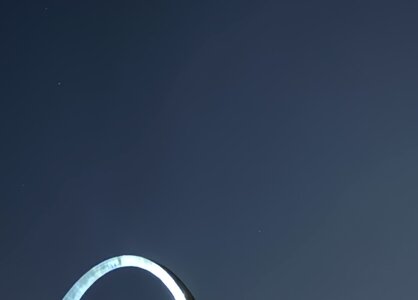
Either the phone’s sensor or its HDR/long exposure processing just completely mangles the color gradient in the sky, with stepped banding that makes the image unusable for anything professional or even getting prints done.
All things considered, it’s an impressive tool that I’m using more and more. It’s a shame the DSLR/mirrorless manufacturers can’t include this level of functionality (on-the-fly HDR, handheld long exposures) on new bodies, as their versions with the bigger sensors should be able to mitigate many of these problems that phone imagery has.

At first glance, this looks amazing. The city and the comet are almost properly exposed with no blown-out highlights. But when you look a little closer, you see the trade-off:

Either the phone’s sensor or its HDR/long exposure processing just completely mangles the color gradient in the sky, with stepped banding that makes the image unusable for anything professional or even getting prints done.
All things considered, it’s an impressive tool that I’m using more and more. It’s a shame the DSLR/mirrorless manufacturers can’t include this level of functionality (on-the-fly HDR, handheld long exposures) on new bodies, as their versions with the bigger sensors should be able to mitigate many of these problems that phone imagery has.
Last edited:
William Monfredo
EF4
How true-- the phone pics satisfy the lcd screen sometimes and people's memories, but often do look strange when printed.At first glance, this looks amazing...But when you look a little closer, you see the trade-off...
No matter which view, they can appear flattened, "plastic," over-sharpened, and stark even though phone photos have gotten better over time.
A real conundrum...how much energy to spend carrying around heavy equipment. Tripods, cameras, lenses get lugged out delivering more light to larger sensors for better pictures; I suppose no pain, no gain.
I've got a Nikon D850 w/ 45 megapixels and f1.4 lenses, among other things, but it often takes motivation to grab that and bring it around. But when I do take it out and shoot RAW, I'm usually not disappointed. I used it for the October 10th aurora (@ f2 for 3 seconds,) but not the comet.
gdlewen
EF4
Went back out on 10/19, and with the moon rising later (57 minutes later each day), hoped for darker skies and a better view of the comet. But also there was a "What a dork moment!" when I realized the proximity of the Milky Way to the comet position. The Milky Way was definitely visible on Saturday night, so this was a chance to try capturing both the comet and MW.
I stacked 15 shots taken with the Z6 (24mm @f/6.3, 13 sec exposure, ISO 2500) as a trial run. The light pollution (LP) from Tulsa and Sand Springs is considerable--literally the bottom third of the frame was washed out prior to processing. While this first attempt at removing the LP has more than its share of issues, I think the project, on the whole, is salvageable.
Fixing this is going to be a bit of a slog: there are way too many degrees of freedom in processing, and more than a few "how-to" videos on YouTube that don't translate to my use case. I think everyone probably develops a workflow based on their tools and experience, so I'm very interested in hearing how others here on ST handle this.
I stacked 15 shots taken with the Z6 (24mm @f/6.3, 13 sec exposure, ISO 2500) as a trial run. The light pollution (LP) from Tulsa and Sand Springs is considerable--literally the bottom third of the frame was washed out prior to processing. While this first attempt at removing the LP has more than its share of issues, I think the project, on the whole, is salvageable.
Fixing this is going to be a bit of a slog: there are way too many degrees of freedom in processing, and more than a few "how-to" videos on YouTube that don't translate to my use case. I think everyone probably develops a workflow based on their tools and experience, so I'm very interested in hearing how others here on ST handle this.
Last edited:
Greg Campbell
EF5
Hannah.Taylor
EF5
Similar threads
- Replies
- 4
- Views
- 853
- Replies
- 3
- Views
- 1K

